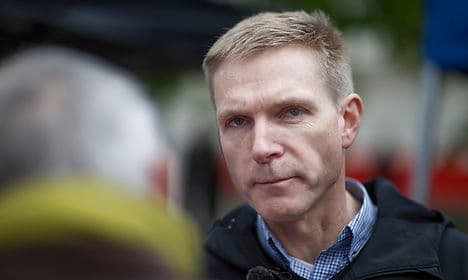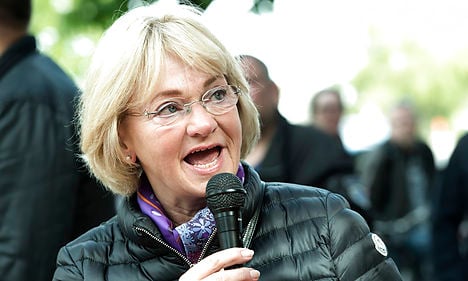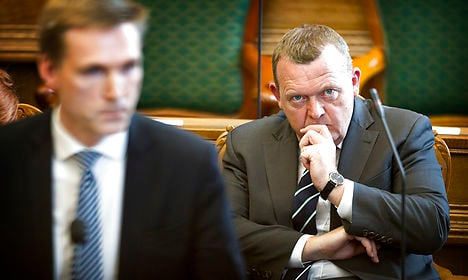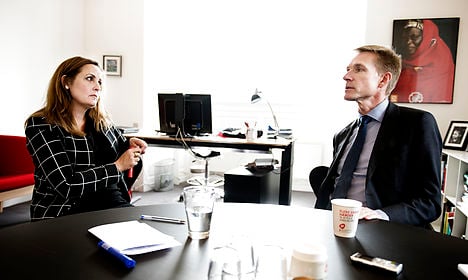The rise and rise of the Danish People’s Party

Since its founding in 1995, the Danish People’s Party has steadily increased its support to become one of Denmark’s most influential political parties and may now be on the verge of joining a new Venstre-led government – if it wants it.
Most known for a tough stance on particularly Muslim immigration, the Danish People’s Party has managed to retain its current position as Denmark’s third-largest party ever since the November 2001 parliamentary elections (held in the wake of the September 11 attacks).
Recent opinion polls suggest that DF is likely to gain as much as 20 percent of the vote in the upcoming elections, snapping at the heels of the traditional giants of Danish politics, the Social Democrats and Venstre.
In a trend mirrored by many other European countries, the Danish populist right is rapidly winning over traditionally moderate voters from both sides of the political spectrum, as surveys have shown that the vast majority of DF’s new supporters voted for the Social Democrats and Venstre in the 2011 election.

Former DF party leader Pia Kjærsgaard addresses supporters. Photo: Jens Nørgaard Larsen/Scanpix
Young blood
DF’s broader appeal among the voting public has also increased significantly since the polarizing Pia Kjærsgaard stepped down in 2012 and was replaced by the younger and more rhetorically restrained Kristian Thulesen Dahl.
Broadcaster DR’s political analyst Jens Ringberg describes Thulesen as being “dressed in the most durable of ‘political Teflon’ – success and voter appeal” arguing that he has been extremely successful at gaining and retaining the loyalty of both old and new supporters.
See also: Ten exciting plots in the Danish election
“In the past one said of the Danish People’s Party and its supporters that whatever Pia does is always the right thing to do. Now, apparently, it’s Kristian Thulesen Dahl who has a very hard time of doing anything wrong [according to his supporters],” Ringberg told DR.
Since Thulesen took over, surveys have also shown a very noticeable change in the demographic makeup of DF supporters. Whereas traditionally they have primarily drawn votes from less-educated, older and lower-income groups, their new supporters are younger, better educated, and firmly middle class.
DF’s growth in popularity has also been boosted by the transformation of voting blocs based more on socio-cultural cleavages than economic ones. Identity politics (particularly issues revolving around the EU, immigration and asylum) has taken on increasing importance in Danish politics since 2001.
In the on-going campaign, for instance, two major discussion points are migrant workers from eastern European countries such as Poland ‘taking Danish jobs’ and the rising number of refugees and migrants from the Middle East and Africa.

Kristian Thulesen Dahl and Lars Løkke Rasmussen. Photo: Nils Meilvang/Scanpix
Can these two work together?
Danish political parties are divided into PM Helle Thorning-Schmidt's 'red bloc' and a 'blue' bloc fronted by Venstre leader and former PM Lars Løkke Rasmussen. The majority of recent opinion polls indicate that the blue bloc will win by a small margin. If that happens, Venstre will once again have the opportunity to form a government, but Rasmussen will need the help of other parties in order to gain a majority. That’s where things get tricky.
From 2001-2011, DF was not formally part of the Venstre-Conservative government, instead providing parliamentary support in exchange for implementing what is regarded as some of Europe’s strictest immigration laws.
Even as his party has grown, Dahl has consistently rejected the notion of being a formal part of a Liberal government. There are several reasons for this.
First and foremost is that DF and Venstre disagree on two core issues: the growth of the public sector (DF wants it to grow by 0.8 percent while Venstre wants to halt spending) and Denmark’s relationship with the EU (Venstre wants to end Denmark’s opt-out on EU judicial cooperation while DF advocates more sovereignty).
Both of these sticking points make it exceedingly unlikely that the two parties could ever form a government platform without significant concessions from one or both sides.

Dahl doesn't want his party to end up like SF, which is now fronted by Pia Olsen Dyhr after a 2014 meltdown. Photo: Liselotte Sabroe/Scanpix
The cautionary tale of SF
Secondly, recent history has given Danish political parties a scare that they are unlikely to forget.
The current government initially consisted of the Social Democrats, Social Liberals (Radikale) and the Socialist People’s Party (SF). SF left the coalition in 2014 following a party meltdown brought on by the controversial sale of state-owned Dong Energy to Goldman Sachs and has been punished severely by voters as a consequence of its unsuccessful time as a minor partner in the coalition.
“The Socialist People’s Party story has illustrated how badly things can go for a party that is part of a government coalition, and the Danish People’s Party has said outright that they do not want to go through a similar experience,” Aarhus University political science professor Rune Stubager told Politiken, drawing comparisons to the closely related Progress Party in Norway, which has also suffered tremendously during its time as a coalition partner in the Norwegian government.
"We want influence"
Finally, DF has already shown it can have the best of both worlds – influence without being forced to compromise – by providing parliamentary support.
When a supporter recently asked him why he was not interested in forming a coalition with Venstre, Dahl said his party would be far better served in a support role than being part of a government.
“We want political influence. We can let the others have their fancy ministerial posts.”
However, a recent survey showed that 69 percent of DF supporters would like the party to be part of a government, and as Stubager notes, “if there begins to emerge a perception that they do not want actual responsibility and to participate in finding solutions, it could cost them voters.”
The real influence that DF is likely to gain from this election however may be more subtle. Already, many parties have hardened their stance on immigration and asylum in an attempt to stop the haemorrhaging of supporters and lure some old ones back from DF. For instance, a recent (and controversial) Social Democrat campaign poster aimed at immigrants and asylum seekers bore the words “If you come to Denmark, you have to work”.
Denmark’s populist right may not be so far to the right anymore – and not because the Danish People’s Party has softened its stance on identity politics, but because the centrist parties have begun to emulate theirs.
Comments
See Also
Most known for a tough stance on particularly Muslim immigration, the Danish People’s Party has managed to retain its current position as Denmark’s third-largest party ever since the November 2001 parliamentary elections (held in the wake of the September 11 attacks).
Recent opinion polls suggest that DF is likely to gain as much as 20 percent of the vote in the upcoming elections, snapping at the heels of the traditional giants of Danish politics, the Social Democrats and Venstre.
In a trend mirrored by many other European countries, the Danish populist right is rapidly winning over traditionally moderate voters from both sides of the political spectrum, as surveys have shown that the vast majority of DF’s new supporters voted for the Social Democrats and Venstre in the 2011 election.

Former DF party leader Pia Kjærsgaard addresses supporters. Photo: Jens Nørgaard Larsen/Scanpix
Young blood
DF’s broader appeal among the voting public has also increased significantly since the polarizing Pia Kjærsgaard stepped down in 2012 and was replaced by the younger and more rhetorically restrained Kristian Thulesen Dahl.
Broadcaster DR’s political analyst Jens Ringberg describes Thulesen as being “dressed in the most durable of ‘political Teflon’ – success and voter appeal” arguing that he has been extremely successful at gaining and retaining the loyalty of both old and new supporters.
See also: Ten exciting plots in the Danish election
“In the past one said of the Danish People’s Party and its supporters that whatever Pia does is always the right thing to do. Now, apparently, it’s Kristian Thulesen Dahl who has a very hard time of doing anything wrong [according to his supporters],” Ringberg told DR.
Since Thulesen took over, surveys have also shown a very noticeable change in the demographic makeup of DF supporters. Whereas traditionally they have primarily drawn votes from less-educated, older and lower-income groups, their new supporters are younger, better educated, and firmly middle class.
DF’s growth in popularity has also been boosted by the transformation of voting blocs based more on socio-cultural cleavages than economic ones. Identity politics (particularly issues revolving around the EU, immigration and asylum) has taken on increasing importance in Danish politics since 2001.
In the on-going campaign, for instance, two major discussion points are migrant workers from eastern European countries such as Poland ‘taking Danish jobs’ and the rising number of refugees and migrants from the Middle East and Africa.

Kristian Thulesen Dahl and Lars Løkke Rasmussen. Photo: Nils Meilvang/Scanpix
Can these two work together?
Danish political parties are divided into PM Helle Thorning-Schmidt's 'red bloc' and a 'blue' bloc fronted by Venstre leader and former PM Lars Løkke Rasmussen. The majority of recent opinion polls indicate that the blue bloc will win by a small margin. If that happens, Venstre will once again have the opportunity to form a government, but Rasmussen will need the help of other parties in order to gain a majority. That’s where things get tricky.
From 2001-2011, DF was not formally part of the Venstre-Conservative government, instead providing parliamentary support in exchange for implementing what is regarded as some of Europe’s strictest immigration laws.
Even as his party has grown, Dahl has consistently rejected the notion of being a formal part of a Liberal government. There are several reasons for this.
First and foremost is that DF and Venstre disagree on two core issues: the growth of the public sector (DF wants it to grow by 0.8 percent while Venstre wants to halt spending) and Denmark’s relationship with the EU (Venstre wants to end Denmark’s opt-out on EU judicial cooperation while DF advocates more sovereignty).
Both of these sticking points make it exceedingly unlikely that the two parties could ever form a government platform without significant concessions from one or both sides.

Dahl doesn't want his party to end up like SF, which is now fronted by Pia Olsen Dyhr after a 2014 meltdown. Photo: Liselotte Sabroe/Scanpix
The cautionary tale of SF
Secondly, recent history has given Danish political parties a scare that they are unlikely to forget.
“The Socialist People’s Party story has illustrated how badly things can go for a party that is part of a government coalition, and the Danish People’s Party has said outright that they do not want to go through a similar experience,” Aarhus University political science professor Rune Stubager told Politiken, drawing comparisons to the closely related Progress Party in Norway, which has also suffered tremendously during its time as a coalition partner in the Norwegian government.
"We want influence"
Finally, DF has already shown it can have the best of both worlds – influence without being forced to compromise – by providing parliamentary support.
When a supporter recently asked him why he was not interested in forming a coalition with Venstre, Dahl said his party would be far better served in a support role than being part of a government.
“We want political influence. We can let the others have their fancy ministerial posts.”
However, a recent survey showed that 69 percent of DF supporters would like the party to be part of a government, and as Stubager notes, “if there begins to emerge a perception that they do not want actual responsibility and to participate in finding solutions, it could cost them voters.”
The real influence that DF is likely to gain from this election however may be more subtle. Already, many parties have hardened their stance on immigration and asylum in an attempt to stop the haemorrhaging of supporters and lure some old ones back from DF. For instance, a recent (and controversial) Social Democrat campaign poster aimed at immigrants and asylum seekers bore the words “If you come to Denmark, you have to work”.
Denmark’s populist right may not be so far to the right anymore – and not because the Danish People’s Party has softened its stance on identity politics, but because the centrist parties have begun to emulate theirs.
Join the conversation in our comments section below. Share your own views and experience and if you have a question or suggestion for our journalists then email us at [email protected].
Please keep comments civil, constructive and on topic – and make sure to read our terms of use before getting involved.
Please log in here to leave a comment.